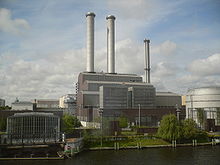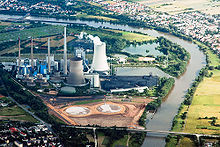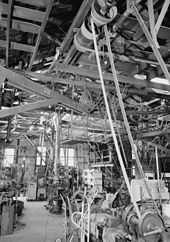Power station
![]()
This article is about the plant for electricity generation. For the band see Kraftwerk (Band), for other meanings Kraftwerk (Begriffsklärung).
A power plant (outdated designation: electricity plant, today also electricity generation plant) is a technical plant for electricity generation and in some cases also provides thermal energy. In a power plant, mechanical energy is converted into electrical energy by means of generators, which is fed into the power grid. The mechanical energy to drive the generators in turn comes from
- kinetic energy (water and wind power plant) or
- thermal energy (via steam turbines, gas turbines or ORC turbines, for example). The thermal energy comes from
- Solar radiation energy (solar thermal power plant)
- geothermal energy (geothermal power plant)
- chemical energy (combustion of coal (coal-fired power plant), oil (oil-fired power plant), natural gas (gas-fired power plant), biomass (biomass-fired power plant), waste) or
- Nuclear energy ((nuclear power plant), possibly nuclear fusion in the future.)
There are also plants consisting of many similar small units, e.g. photovoltaic plants. They are also called power plants, although they do not contain any moving parts and therefore kinetic energy does not occur as a form of energy in the conversion chain.
The respective primary energies are converted into electrical energy in these energy conversion chains with varying degrees of efficiency.
All methods are in economic competition with each other and are politically partly promoted (renewables: solar, hydro, wind, geothermal), partly additionally taxed (nuclear fission: fuel element tax; incineration: carbon dioxide emission).

Weisweiler lignite-fired power plant

Hengstey run-of-river power station

The combined heat and power plant (gas power plant) Berlin-Mitte is used not only to produce electricity but also to supply district heating to the government district.

Staudinger coal-fired power plant in Großkrotzenburg
Historical development
See also: History of production engineering
Until the end of the 19th century, the energy needed was generated by steam power in addition to human and animal power. Steam engines were used to generate mechanical power, which was transferred to the machines in factories by means of transmissions. Other known sources of energy were water power and wind power. These primary energy sources could only be used in the immediate vicinity.
It was not until the invention of the dynamo machine that the prerequisite was created for spatially separating the place of energy release from the place of energy consumption. Werner von Siemens, who discovered the dynamoelectric principle in 1866 and equipped the first dynamo machine with it, is the preferred inventor of the generator without permanent magnets. Even before Siemens, however, Ányos Jedlik in 1851 and Søren Hjorth in 1854 had used the current generated by the machine itself to feed the field magnets and described this. The first patent was granted to Søren Hjorth in 1854. The first power stations were powered by steam engines, and electricity grids were created to distribute the energy. In the electricity war, a system competition at the end of the 19th century between the methods of the type of electricity to be used, three-phase alternating current, a form of alternating current with three phases, prevailed for electricity networks with a few exceptions. With three-phase high-voltage transmission, larger transmission distances can be realized in the form of extended interconnected networks with acceptable transmission losses.
The combustion of coal in steam boilers for the generation of electricity was quickly recognized as a further sales market by the colliery operators. Starting from the colliery power plants, the electricity was distributed to neighbouring industry and private households. After electricity had initially been used mainly for lighting purposes, the general availability of energy led to new innovative electricity-powered machines in industry and in private households and thus to a further increase in electricity generation. Today, a highly developed state is unthinkable without power plants and an electricity grid.

Transmission and belt-driven machines before the introduction of electric motors

Germany's oldest preserved hydroelectric power plant (1891) in Schöngeising ⊙48 .13720211 .208085 . In the former East Prussian town of Darkehmen, a hydroelectric power plant had already existed since 1886.
Physical basics
Power plants convert non-electrical energy (thermal, mechanical, chemical, solar or even atomic energy) into electrical energy. The energy conversion is always associated with exergy losses. The energy used (fossil energy, radioactive materials, sun, wind, biomass, hydroelectric power) forms the primary energy and the electricity the secondary energy. Electric current forms a very high quality energy that can be transmitted over a very long distance and converted into other types of energy. Since only a part of the energy can be converted into electrical energy, there is always a portion of energy that cannot be used, which is released into the environment as entropy. The best known form of waste heat is cooling tower steam. In the case of solar energy, the silicon wafer heats up when the incident photon has not lifted an electron from the conduction band. In the case of hydroelectric power, friction heats the useful water slightly.
Questions and Answers
Q: What is a power station?
A: A power station is a place where electricity is produced.
Q: How do big power stations generate electricity?
A: In big power stations, electricity is generated by a big spinning electrical generator. The spinning is usually driven by a steam turbine.
Q: What are the different sources of steam used in power stations?
A: The different sources of steam used in power stations include burning fossil fuels, nuclear power using radioactive sources, using the earth's heat called geothermal energy, and using the sun's heat.
Q: Are there any power stations that do not use steam engines to spin the generator?
A: Yes, there are some power stations that do not use steam engines to spin the generator. They use hydropower, which uses the power of moving water to drive turbines, wind turbines, or internal combustion engine power. A few power stations use the sun's rays to generate solar power without motion.
Q: Why are there so many power stations around the world?
A: There are many power stations around the world because many things need electricity to work.
Q: How do power stations operate?
A: Power stations may be operated as Load following power plant, peaking power plant, or base load power plant.
Q: What are Load following power plants, peaking power plants, and base load power plants?
A: Load following power plants follow the demand for electricity, peaking power plants are used when demand for electricity is high, and base load power plants operate continuously to meet a minimum demand for electricity.
Search within the encyclopedia